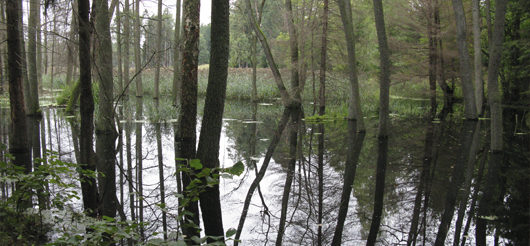Water is an essential factor in SFM, and forests are crucial for regulating the water cycle. One of the challenges for forest managers is to maximize forest benefits while conserving water resources.
Forests need water
Forests are important water users. Trees use water at their highest rate when they have reached their final height (that is, the maximum height they will grow in their lifetimes) and during the season of their most intensive growth. The amount of water used by forests is also influenced by climate, topography, soil, forest age, species composition and management practices. Either too little water (as a result of insufficient precipitation or a reduction in groundwater availability), or too much (i.e. waterlogging), can have a negative effect on forest health.
Forests provide and regulate water
A large part of the world’s drinking water comes from forested areas, and millions of people depend on high-quality freshwater flowing from forests. For example, the forests of the Uluguru Mountains supply drinking water to the 2.5 million residents of the Tanzanian capital, Dar es Salaam. Similarly, 1.3 million people in Quito and 20 million people in Mexico City get their drinking water from mountain forests. Forests help maintain high water quality, influence the volume of available water, and regulate surface and groundwater flows. Forests also help reduce water-related risks such as landslides, floods and droughts and prevent desertification and salinization.
Forest buffer extreme weather
Forests perform important buffering functions, such as cooling effects, the interception of precipitation, and water infiltration and retention. Forests can therefore mitigate extreme weather and reduce the impacts of climate change on water resources. Conversely, forests themselves are vulnerable to the effects of climate change, such as reduced or changed precipitation patterns. Forest managers should aim to reduce the vulnerability of forests to water stress and increase their role in ensuring a continuous water supply (see climate change adaptation and mitigation).
Forest water management
Water management priorities in forests depend largely on the physical geography of the forest, and they are likely to differ in lowlands (where precipitation is lower and water infiltration is higher because of gentler slope gradients) and uplands (where there are more frequent and extreme precipitation events, shallower soils and steeper slope gradients with more surface runoff). Management guidelines exist for the following specific, water-sensitive forest contexts:
- mountain cloud forests;
- swamp forests;
- forests on saline-susceptible soils;
- riparian buffer zones;
- vernal pools (a distinctive form of wetland); and
- avalanche protection forests.




